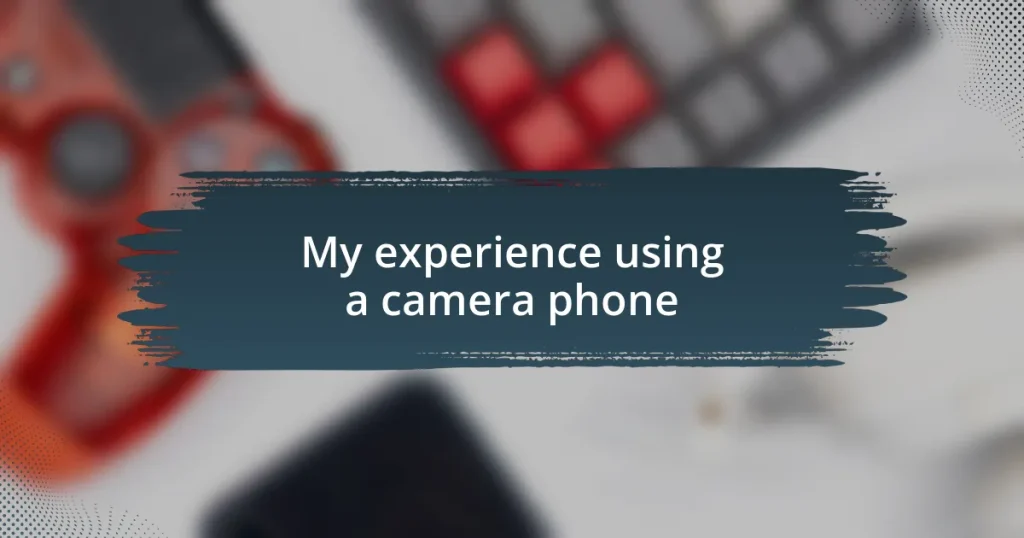Key takeaways:
- Experiencing photography through camera phones can transform ordinary moments into artistic expressions.
- Choosing a camera phone with higher megapixels, a wider aperture, and optical image stabilization significantly enhances photo quality.
- Understanding camera specifications empowers informed decisions and improves photography skills.
- Techniques like composition, lighting, and editing are crucial for creating impactful and vibrant images.
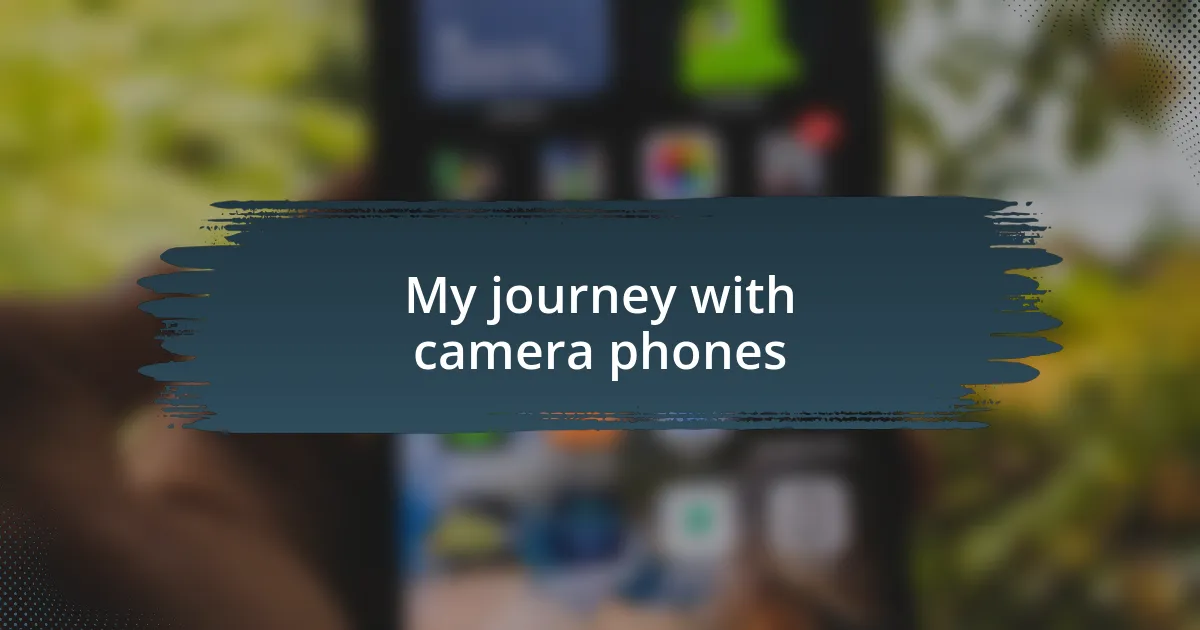
My journey with camera phones
I still remember the first time I took a picture with a camera phone. It was an old model, but capturing a spontaneous moment of laughter with friends felt revolutionary. Wasn’t it amazing how something as simple as that could preserve a memory forever?
As I upgraded to newer models, I found myself diving deeper into photography. I started experimenting with different angles and lighting, realizing that I could express my creativity even with a device meant for convenience. It was exhilarating to see how an ordinary moment could transform into something artistic, all from my pocket.
Eventually, I began sharing my photos online, connecting with others who shared the same passion. The supportive community made me feel like I wasn’t just a casual user; I was part of a larger artistic movement. Have you ever felt that sense of belonging through your own photography? For me, it was a journey of discovery, revealing not just my skills but also the stories behind each snapshot.
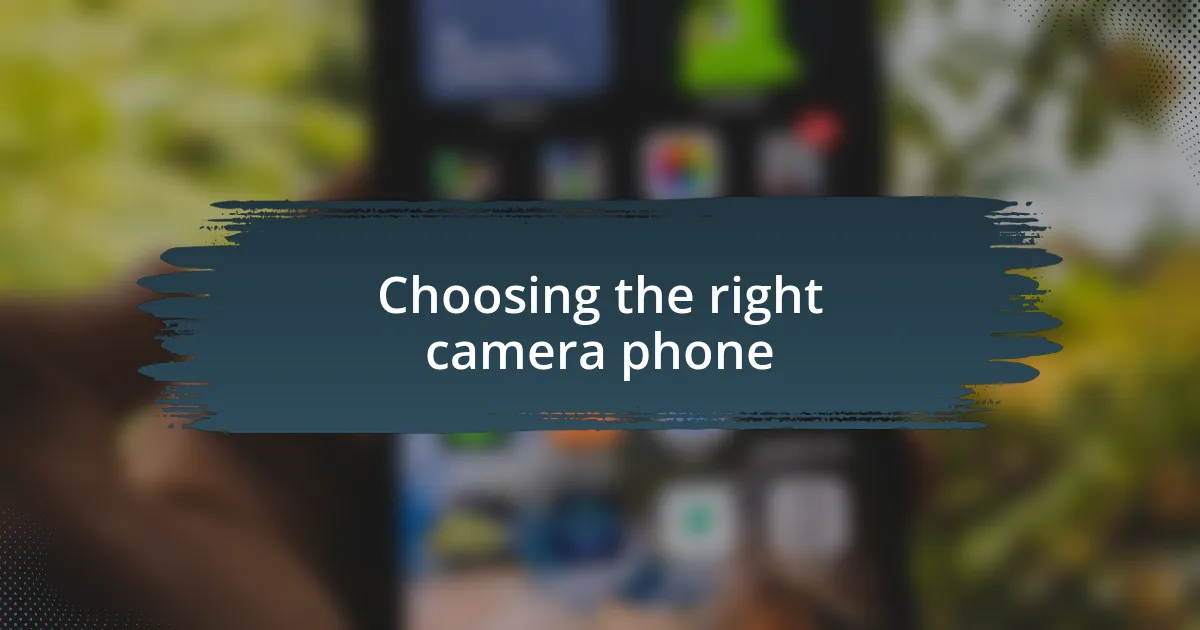
Choosing the right camera phone
Choosing the right camera phone can be a game-changer in your photography journey. I remember my excitement when I first decided to invest in a phone with a higher resolution camera. It was like swapping an ordinary palette for vibrant colors; suddenly, every shot I took had more clarity and detail, enabling me to capture the beauty around me more effectively.
When I started comparing various models, I discovered that factors like camera megapixels, aperture size, and image stabilization played crucial roles in photo quality. I was surprised by how much difference a wider aperture made for low-light shots. It felt like unlocking a new level of creativity—I could now take stunning pictures during evening outings without rummaging for my DSLR.
Let’s not forget the importance of post-processing capabilities. Some phones come with enhanced editing features that let you adjust brightness and contrast directly from the gallery. Personally, having these tools at my fingertips transformed my photography; I could create moodier or more vibrant images without needing specialized software. As I dived deeper into this world, I realized that choosing the right camera phone was not just a technical decision but a significant step in expressing my artistic vision.
| Feature | Phone A | Phone B |
|---|---|---|
| Megapixels | 108 MP | 64 MP |
| Aperture | f/1.8 | f/2.2 |
| Image Stabilization | Optical | Digital |
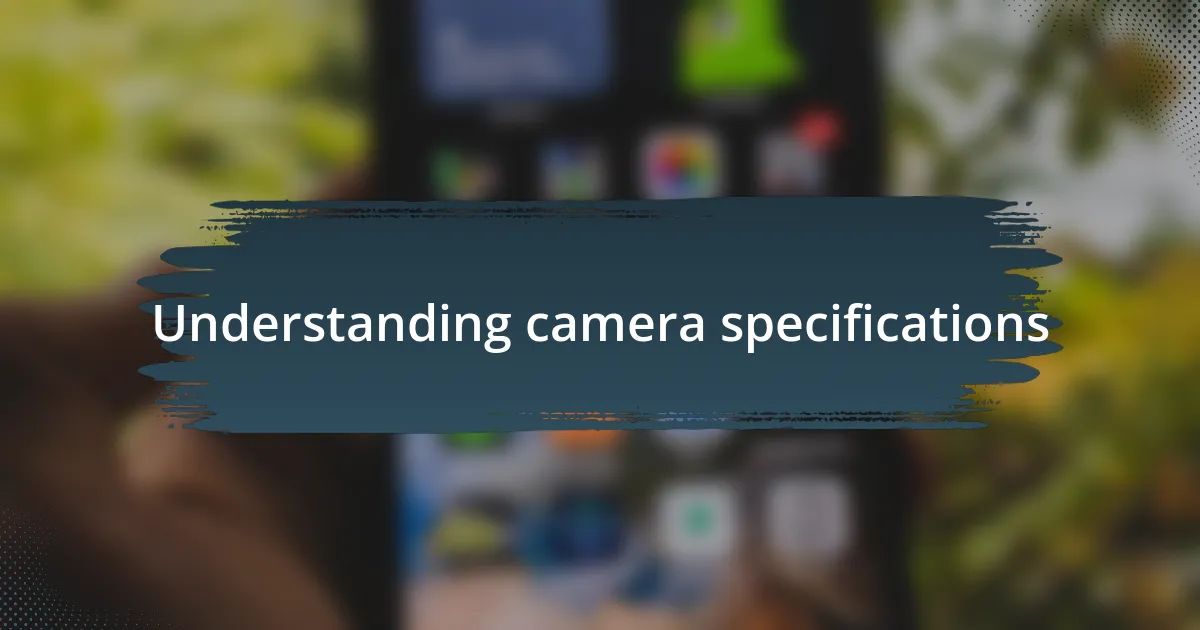
Understanding camera specifications
Understanding camera specifications can be somewhat overwhelming at first glance, but trust me—getting familiar with them will significantly enhance your photography experience. When I first delved into the technical side of camera phones, I was astonished to find that it wasn’t just about the megapixels. Each specification told a story about how the camera might perform in various situations. For example, knowing that a phone has optical image stabilization (OIS) versus digital stabilization made a world of difference in the clarity of my on-the-go shots.
Here are some crucial camera specifications to consider:
- Megapixels: Higher megapixels mean more detail, but it’s not everything for photo quality.
- Aperture: A lower f-number (like f/1.8) allows more light, ideal for low-light settings.
- Image Stabilization: Optical stabilization helps reduce blurriness in photos, particularly when shooting without a tripod.
- Sensor Size: Larger sensors can capture more light, leading to better image quality overall.
- Lens Quality: The glass used in the lens affects sharpness and color accuracy in your photos.
As I grasped these concepts, I felt empowered to make more informed choices that fit my style, turning what used to be guesswork into a mindful process of selecting the best camera phone for my needs.
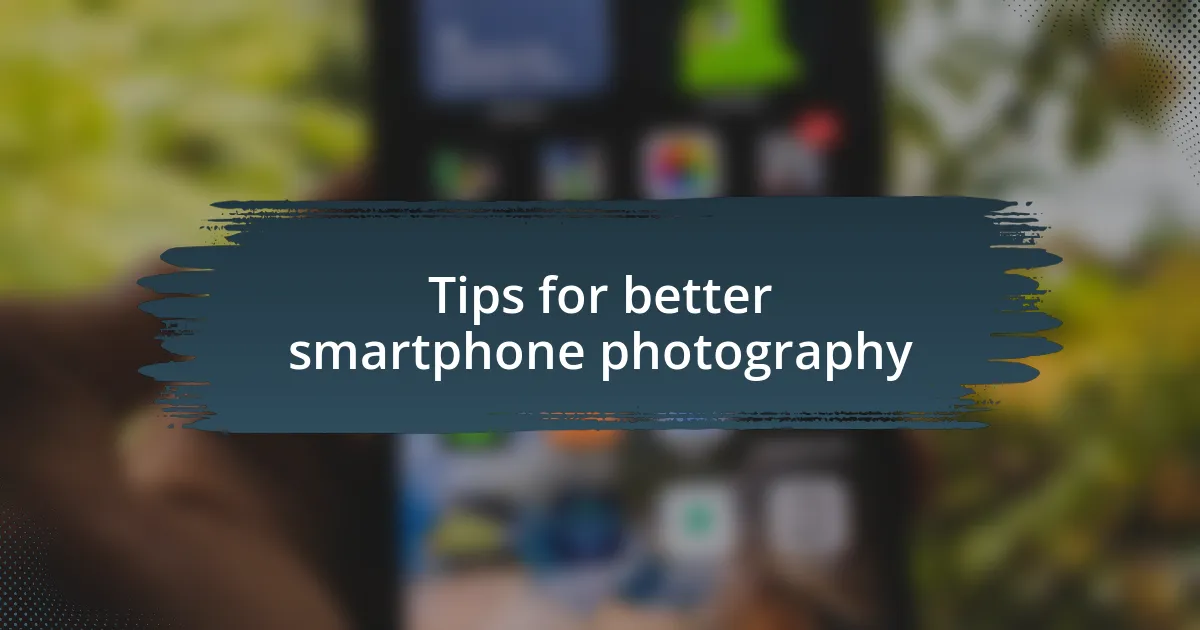
Tips for better smartphone photography
Recently, I discovered that the composition of a shot can dramatically change its impact. I used to just snap away, but now I make a conscious effort to frame my subjects in interesting ways. Have you ever noticed how a slight shift in angle can bring a whole new story to the image? It’s remarkable how something as simple as the rule of thirds can elevate your photos from mundane to captivating.
Another trick I’ve embraced is utilizing natural light—it’s a game changer. On a sunny afternoon, I took candid shots of my friends laughing in the park. Their joy illuminated not just their faces but the whole atmosphere. I realized that timing my shoots during the golden hour, when the sun is softer and warmer, makes everything look magical. What can be more rewarding than capturing that perfect moment, bathed in the most flattering light?
Lastly, I can’t stress enough the importance of keeping my lens clean. It sounds trivial, but when I finally polished the lens before a weekend trip, the difference was astonishing. Suddenly, the previously dull photos transformed into crisp images filled with vibrant colors. Have you ever taken a shot only to realize later that smudges were ruining it? Trust me, a quick wipe can turn an average photo into something you’ll be proud to share.
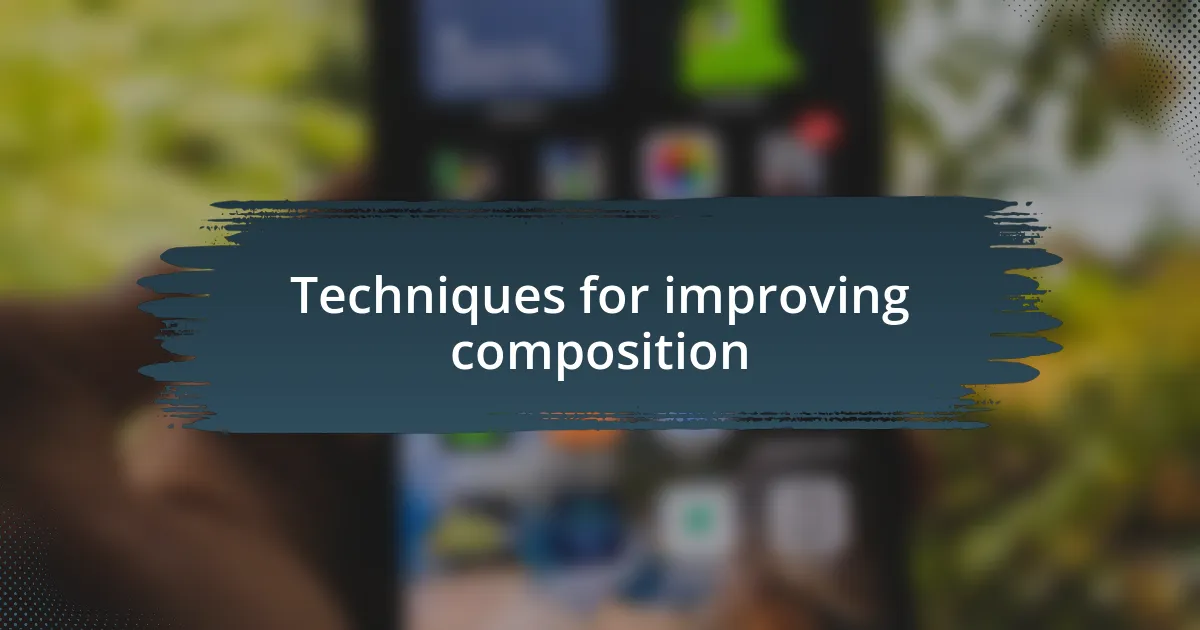
Techniques for improving composition
One technique that has really enhanced my smartphone photography is the use of leading lines. I remember wandering through an old city, captivated by a narrow cobblestone street that seemed to stretch endlessly. By positioning my camera to frame the lines of the road leading into the distance, I created an inviting path for the viewer’s eye. Have you ever experienced that feeling of being drawn into a photo? It’s a powerful way to engage your audience.
Another aspect I’ve found crucial is balancing the elements within my frame. During a recent hike, there was a stunning waterfall surrounded by lush greenery. I made it a point to include some foreground elements, like a few rocks, which added depth and context to the scene. It’s amazing how adding or adjusting just one element can lead to a more harmonious composition. When was the last time you adjusted your framing to create balance, only to discover a more compelling narrative?
Finally, experimenting with perspectives has opened up a whole new world for me. One day, while at a local market, I decided to crouch down and shoot at the height of the vibrant produce displays rather than standing above them. The resulting images felt so much richer and more immersive. Isn’t it fascinating how changing your point of view can provide a fresh take on a familiar scene? I encourage you to play with different angles; it might just transform how you see the world through your camera.
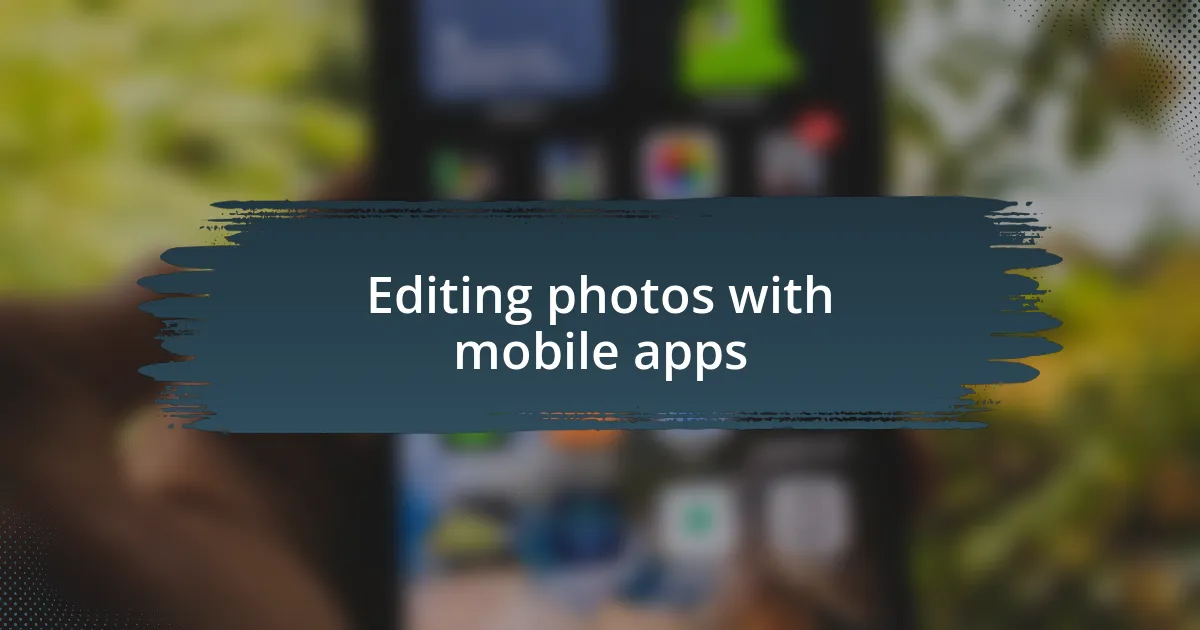
Editing photos with mobile apps
Editing photos on mobile apps has become a game-changer for my smartphone photography. Recently, I was thrilled to discover a feature in one of my favorite apps that allows for fine-tuning shadows and highlights. It was a dreary day when I captured a bustling street scene while the clouds loomed above; when I adjusted the shadows, suddenly the colors popped, transforming a dull photo into something vibrant and energetic. Have you ever felt that rush of excitement when a simple tweak brings an image to life?
One of the most enjoyable aspects of photo editing for me is experimenting with filters. During a recent vacation at the beach, I tried a warm filter on a sunset shot, and it added a golden glow that perfectly captured the mood of the moment. It’s amazing how a filter can not only enhance an image but also evoke emotions. Do you have a favorite filter that transforms your photos in unexpected ways?
I also cherish the editing tools that allow me to crop and straighten images effortlessly. Just the other day, I noticed a stunning landscape shot that was a bit tilted. After aligning the horizon and removing distractions at the edges, it felt like I had unlocked a new level of clarity. Isn’t it incredible how a small edit can elevate an entire photograph and ensure that the focus remains on what truly matters? Each little adjustment serves as a reminder that editing isn’t just about enhancement; it’s about storytelling.











